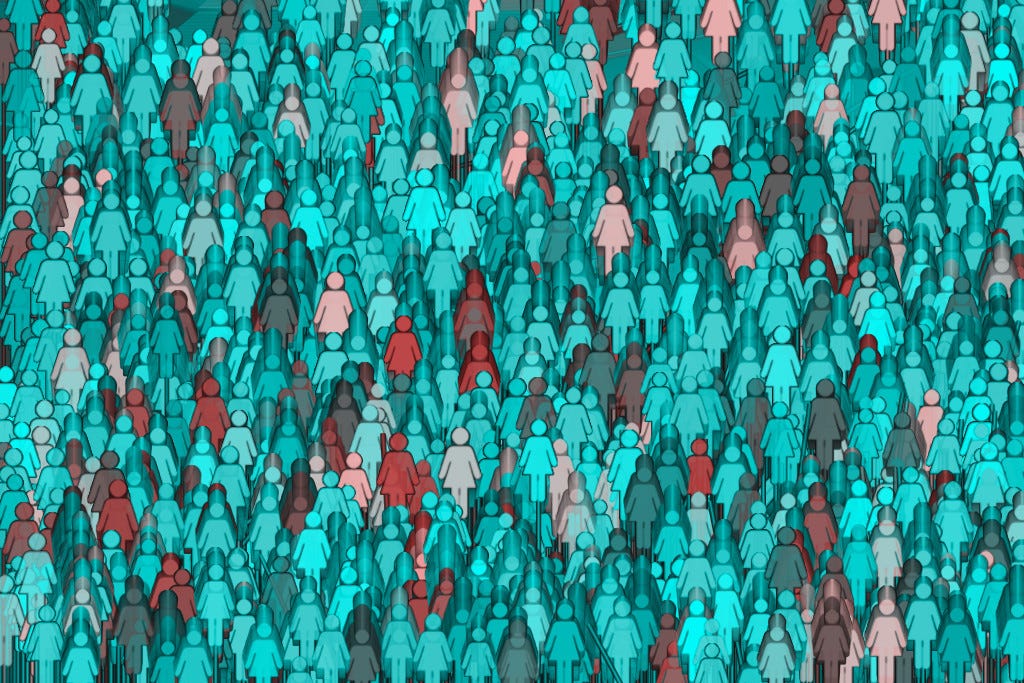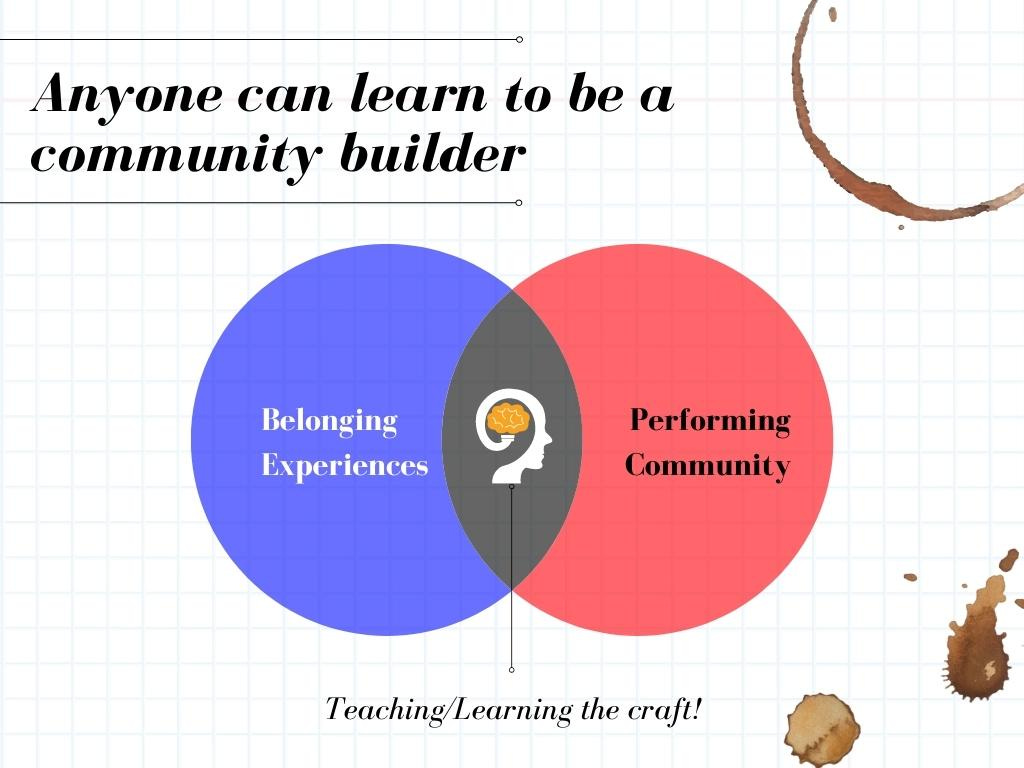Can community building be taught? A response to Laís de Oliveira
TL;DR Yes-ish: Community building is a performing art that anyone can learn, but not anyone can teach

The past January 26th I received a newsletter by Laís de Oliveira where she explored the question that entitles this essay. Her newsletter featured a LinkedIn post by herself about the same question: can community building be taught?
There she said she’d love to hear what we think on this topic. So… you brought this [essay/maunder] to yourself, Laís 😜
First, the question is deceptible simple. A straightforward answer may be tempting: “yes, it can be taught because…”, “no, it cannot be taught due to…”
But as Laís skillfully unveiled in both her newsletter and post there are many sub-topics that should be explored in order to give a comprehensive answer.
So… I’ll address some of those topics step by step trying to build a good response.
I. The question of belonging: “🙌 Belonging is intrinsic to any human experience. Every person is a community builder in potential”
This first statement has two basic premises: (1) Belonging is intrinsic to any human experience, and (2) Every person is a community builder in potential.
The first premise I believe hides two assumptions: (1) All human experiences are belonging experiences, and (2) that is because belonging is intrinsic to being humans.
I fully agree with the second assumption. Belonging is utterly human. I would even dare to go further and say belonging is crucially human. To be human is to belong.
I argue this because our nature as social animals (social beings) demand the organization and the creation of relationships.
As I explored in another essay:
Communities are a consequence of our gregarious nature as human beings “for man is not a solitary or unsocial creature, but born with such a nature that not even under conditions of great prosperity of every sort is he willing to be isolated from his fellow men”.
Now, regarding the first assumption, I have a small nuance to propose. I am not sure if belonging is intrinsic to any human experience.
First, I understand belonging conveys organized co-ownership as I stated here:
A community is co-owned by those that “walk together” towards a shared goal.
One great example of this is the gaming communities where disymbol players agree to some rules in order to achieve something, let’s say: finish the game in the less possible time.
In a community, the partners are called members. This is because the word member conveys much more meaning. What is a member but a living part, a limb, of a bigger, unitary, organized organism? Partners associate. Members belong.
Following this approach, there are many human experiences that are not related to belonging: the experience of raw pain, the experience of being light-blinded, etc. Even the judgement over these experiences is not necessarily related to belonging.
But (and this is a huge but), our social nature sheds light over all our conscious experiences and makes us relate to others with similar experiences: we discover ourselves as belonging members of a subset of people with shared experiences.
This social nature and the “membership light” shed over our experiences are the foundation for the second premise. Yes, I agree, every person is a community builder in potential, but this potency needs a spark to become act. I’ll tackle that later in this essay.
Can community-building be taught? Only considered as a skill that emerged from the experience of our human nature, I would have to say “no”. We cannot teach experiences.
II. The question of expertise: “👷🏽♀️ Community is a practice. Community building is an action verb”
This second topic in the original post I loved.
First, because practice and activity are concepts deeply connected to the experience we’ve been discussing, but under another meaning: “the knowledge or skill acquired by the practical contact with and observation of facts and/or events”.
Here we are not talking about the human occurrences that leave impressions on someone, but the practical knowledge earned by any agent.
Here I agree with Laís: Community-building is a verb: it is a creative and productive action.
Now, if I could add another nuance to this idea is to think community not as a practice… but as a happening or even a performance!
The Tate Museum defines a performance as “Artworks that are created through actions performed by the artist or other participants, which may be live or recorded, spontaneous or scripted”.
I cannot write this without a smile on my face, we could interchange the word “performance” for “communities” and it makes all the sense, I think: “Communities are created through actions performed by the community builder or other participants, which may be live or recorded, spontaneous or scripted”.
Even more, the Tate continues:
performance [community] has been understood as a way of engaging directly with social reality, the specifics of space and the politics of identity.
Just like art, community-building was circumscribed to specific narratives, institutions and media but, again, just like art, community-building has a renewed and fresh life at the borders that in the past 100 years or so has opened their way to the centre, to the mainstream1.
If we think of community as a practice we would be right, but I think we would be missing a big chunk of meaning. We practice community when we perform community-building. Community is performing.
Ok… maybe I should dive deeper into this idea of community-building as performing, but this essay is becoming too large, so let me know if you’d want me to write more about it.
Can community-building be taught? Considered as a practical skill that is earned from exposure to certain activities, I would have to say “yes”. We can teach practices.
III. The Ratatouille effect: “Anyone can learn it. You can teach anyone who is willing to put in the work”
In the middle of the emerging discipline of community-building, the words of Anton Ego reverberate filled with clarity:
In the past, I have made no secret of my disdain for Chef Gusteau's famous motto, "Anyone can cook." But I realize, only now do I truly understand what he meant. Not everyone can become a great artist; but a great artist *can* come from *anywhere*. (Pixar, Ratatouille, 2007)
As I said in the first section of this essay, every person can become a community builder. Here I fully agree with Laís, and this potentiality rests precisely in the human experience of belonging and in the experience acquired by the practice within communities.
For me, this third topic raised by Laís lives in the intersection of the first two statements:
Now, as Laís herself points out, the required follow-up question is “how”. She says:
The best way to learn is by doing and from doers. As an emerging knowledge field, the art and science of building community are still in the process of being unveiled and created (…) As with anything under construction, the best (maybe only) way to learn is by experimenting, which can be accelerated by sharing experiences with others who are in the same boat.
I agree. Community building, like any other art or craft, demands practical knowledge: the understatement of the particular actions needed to produce the desired effects2.
This knowledge starts with the experience and with the most evident features of the communities, but require effort and willingness to put in the work. And this effort can be more efficient when approached from an experimental fashion and “accelerated by sharing with others who are in the same boat”, as Laís put it.
Regarding the relationship between those who learn and those who teach community-building, I think the best approach is the one outlined by Heidegger 70-ish years ago:
Teaching is more difficult than learning because what teaching calls for is this: to let learn. The real teacher, in fact, lets nothing else be learned than — learning (…) The teacher must be capable of being more teachable than the students. (Martin Heidegger, What is Called Thinking)
This is the challenge of teaching-learning community-building: experience can be shown but must be lived. The theoretical knowledge is helpful but is not useful.
The best way to learn how to build a community is by performing, and the best way to teach community-building is by letting perform.
Can community-building be taught? Considered as the intersection of experiences and practices, of nature and craft, I would say… only when you let the people learn by doing it.
IV. The pending question: “🙋🏽 can we hire someone to belong? As in, can we hire and train a community manager from scratch?”
I will address this question in my next essay, for I also do not have an answer yet. Yet, I believe I can provide some insights from previous experiences I have in a stand-alone text:
The “Coparmex” case: a Mexican businesspeople union
The “Eudoxa” case: a semi-successful business case of hiring to belonging
I’m looking forward to reading your comments on these ideas!
I was deeply inspired by this idea by Arthur Danto’s “The End of Art” and this Youtube video by Ter:
Cf. Aristotle, Metaphysics, I, 980a




